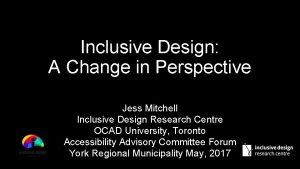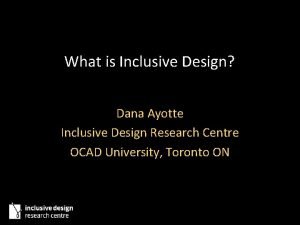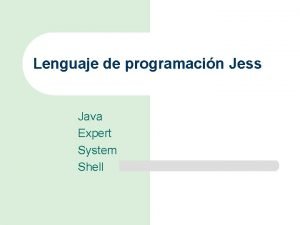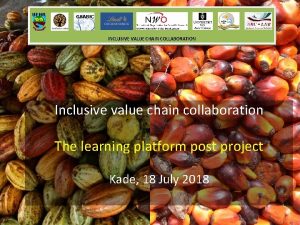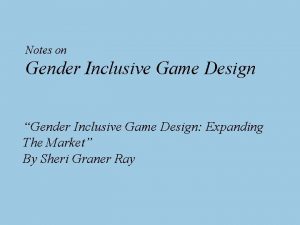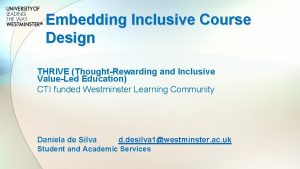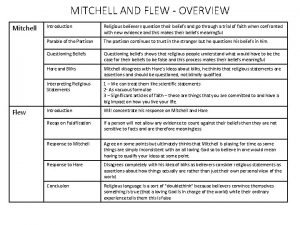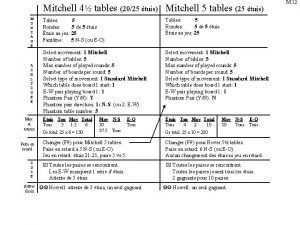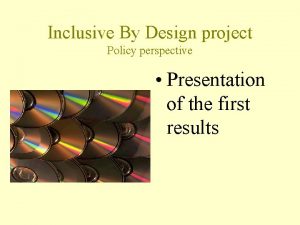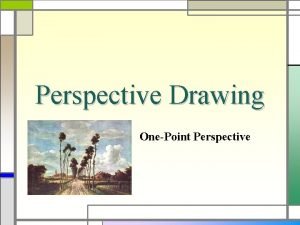Inclusive Design A Change in Perspective Jess Mitchell





















- Slides: 21

Inclusive Design: A Change in Perspective Jess Mitchell Inclusive Design Research Centre OCAD University, Toronto Accessibility Advisory Committee Forum York Regional Municipality May, 2017

What is Inclusive Design

3 Principles of Inclusive Design 1. Recognize diversity and uniqueness 2. Use an inclusive process & inclusive tools 3. Have a broader beneficial impact

Sitting at the Table

About this Table… • Who isn’t here? • Is the table welcoming to all? • Have they been at the table before? • Do they know the culture of the table? • Is the environment the table is in safe, welcoming, open? • How is listening and capturing going to happen at the table? • Do those at the table have real ways to have an impact? Are they empowered to act on what is discussed?

What is Disability?

Mismatch

All experience mismatch Disability is a mismatch Mismatch is solvable Inclusive Design/Thinking can solve mismatch

How can we do inclusive design and inclusive thinking? 1. Recognize diversity and uniqueness 2. Use an inclusive process & inclusive tools 3. Have a broader beneficial impact

Principle 1 + Action A. Recognize diversity and uniqueness a. b. c. d. e. Of people Of places Of contexts Of comfort Of discomfort Empathy | Listening | Curiosity | Learn | Make Mistakes Challenge your own implicit biases

Principle 2 + Action A. Use an inclusive process & inclusive tools a. b. c. d. Interactions Building, room, table, chairs Form and Function Co-design Awareness | Perspective | Question Assumptions Challenge your own implicit biases

Principle 3 + Action A. Have a broader beneficial impact a. Begin to address biases in ourselves and others b. See beyond the minimum c. Recognize all the DESIGN decisions you make a. Ask: who did you just exclude? Awareness | Perspective | Question Assumptions Challenge your own implicit biases

*This* is innovation 1. Recognize diversity and uniqueness 2. Use an inclusive process & inclusive tools 3. Have a broader beneficial impact

Trampoline

Path

Chair

Stop. Gap

Learning

Contacting Me: • Twitter: @jesshmitchell • Email: jmitchell@ocadu. ca

Images used: • Welcome Mat • Flickr Link • Picnic Table • Wikipedia Link • Accessibility images • • Wikipedia image link • Square Peg – Round Hole • Flickr Link • Trampoline • Image Link • Path in park • Image Link • Desk Chair Combo • Flickr Image • Stop. Gap Wedge • Image Link

Discussion Questions 1. how are you “accomplishing” or solving for inclusion now? 2. What are practical ways you can approach inclusion differently after today? 3. What are particular areas of inclusion and accessibility you’d like to address that are not changing?
 Jess de jesus
Jess de jesus Jess mitchell ocad
Jess mitchell ocad Inclusive design toronto
Inclusive design toronto 2 point perspective boxes
2 point perspective boxes Silo perspective vs business process perspective
Silo perspective vs business process perspective Anthropological social change
Anthropological social change Jess h brewer
Jess h brewer Jess durante
Jess durante Jess expert system shell
Jess expert system shell Chicas de alambre
Chicas de alambre Jess vs mira
Jess vs mira Jess vs mira
Jess vs mira Jess is a forward chaining
Jess is a forward chaining Jess gylnne lgbt influencer
Jess gylnne lgbt influencer Jess rules engine
Jess rules engine Expert system shell example
Expert system shell example Carla jess
Carla jess Jesse aarons bridge to terabithia
Jesse aarons bridge to terabithia Jess caballero
Jess caballero Jess tutorial
Jess tutorial Jess glynne background
Jess glynne background Jess salgado wikipedia
Jess salgado wikipedia

